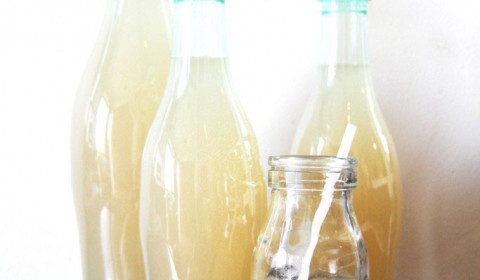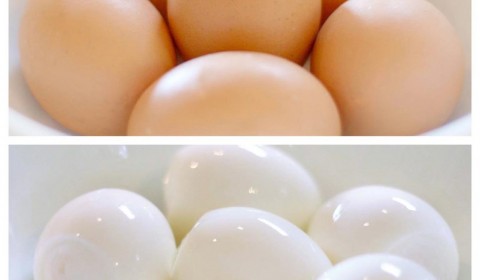The problem is a lot of people are afraid to try their hand at poaching thinking it’s too difficult a method. This is where the cling film method comes in, but before you say something about the rubbish left from such a cooking method, yes I agree but the greatest benefit of poaching eggs using this method is you can use older eggs!
The traditional method of poaching requires you to have the freshest eggs so that the egg white is a firm ball surround the yolk. This is important because you need the white to hold form in the water. Using an older egg will mean the egg white is looser and you will just have egg white ‘ghosts’ floating around in your saucepan. Not very appealing at all!
Poaching in cling film means you can use older eggs – not everybody has chickens on hand and not every carton of eggs you buy are as fresh as you need them for traditional ‘free fall’ cooking, so having this method on hand is very helpful when the craving for poached eggs hits.
How to test the freshness of your eggs… incase you were wondering…

Carefully place an egg or eggs into a glass or container filled with water.
If they float then they are no good… It means the egg is old enough to have moisture and carbon dioxide leave the egg and external air replace the volume in the air pocket inside the egg. If you choose to still crack it open to confirm the test then I suggest doing it outside.
If they sink to the bottom then it’s a good egg… The flatter it lays, the fresher it is – there is no air inside the air sac yet. It’s still a viable egg if it’s dancing on it’s tip, it just not as fresh.
This test is basically fail safe and great when you don’t want to crack the egg open to find out how old it is.
Ingredients for poaching…
55g – 60g Eggs
Cling film – OSO Cling Film brand does not need oil to stop the eggs sticking to it, nearly all other brands do.
Small cup or bowl – non clingy plastic or pottery ideally
Spray oil
Saucepan of boiling water
Method For poaching…
Place cling film over the cup and spray lightly with oil.
Break one egg into the covered bowl.

Gather the edges together and twist to secure, making sure you expel all the air as you do.
Place into boiling water and cook for 4 minutes if straight from the fridge, a little less if your egg is at room temperature.
Once cooked, remove from the water and snip off the top of the cling film. Open the top and let the egg slip out.
Voila! One perfectly poached egg
Other how to’s…
- 55g – 60g Eggs
- Cling film – OSO Cling Film brand does not need oil to stop the eggs sticking to it, nearly all other brands do.
- Small cup or bowl – non clingy plastic or pottery ideally
- Spray oil
- Saucepan of boiling water
- Place cling film over the cup and spray lightly with oil.
- Gather the edges together and twist to secure, making sure you expel all the air as you do.
- Place into boiling water and cook for 4 minutes if straight from the fridge, a little less if your egg is at room temperature.
- Once cooked, remove from the water and snip off the top of the cling film. Open the top and let the egg slip out.
- Voila! One perfectly poached egg









Top marks from me.!
No more messing with vinegar , or swirling around.
This method is THE BEST.
I used a little brushed on oil. and find 4 minutes is best for me.
Fantastic.
Agree, simple huh! I once by accident tied the cling wrap way too tight, it exploded on me. Oh well, learnt very quickly what not to do next time. 🙂 Bella
Hi. If I want to poach eggs in advance, I under-poach them and plunge them in cold water, then and when I want to serve, ! plunge them back in simmering water for about 1 minute. I presume that this would work with your method, but how long would you poach them for in the first instance? I need them to have soft yolks after they have been re-heated.
Thank you for considering this question.
You forgot to add the egg….
😆 Yes! Thnx. Now updated.
I havev been poaching eggs forever (so it seems) some misses but more hits, however your method
sounds foolproof. I am 83 and love a poach or 2 for breakfast, my favorite style of egg although I
like all cooking methods. I will try your method as it sounds less messy and easier to do. Keeping
fingers crossed.
Hi Joan. This method is so good and basically faultless … enjoy your newly learnt cooking method 😃
Cheers,
Katriina
Your poached eggs are good thank you
Thanks so much 🙂
After all I found out the reason that why I was not successful in doing so. Yes! obviously the old eggs. I live in a relatively hotter climate, the egg gets to much thin and of course the older in warm temperature. You get me to the way now. I will try and I am confident that, this time I will make it happen.
Hi Smokeryard, Yes! The older eggs just aren’t up to the cooking method of poaching without being contained.
So happy to have opened up poached eggs of any age to you 🙂
Cheers,
Blondie
Thank you for the tutorial on the “poaching of an egg” , I’m very keen to try.
Question, can I poach the eggs the afternoon prior to using the next morning, if so what is the procedure for storing?
Hi Bill,
Good question… Yes you can poach the day before (great for when you are feeding an army of people). Once poached, drop them into an ice bath and bring the temperature right back down and store that way till ready to reheat. The next morning, place eggs into a pot of boiling water for about 30 – 40 seconds and then remove the cling film and serve.
Good luck! Blondie 😃
I hope I never have to meet the person who gets upset over the wastage of a bit of cling film. They sound like a pain in the butt!
Thanks for the tips!!
😄 You are more than welcome!
Blondie
Smart! Love this idea. I’ll try this today. Hopefully it doesn’t fail. Thanks!
Hi Alex, Good luck! Just remember that you may need to oil the cling film… Cheers, Blondie
This is awesome! Will try it first thing tomorrow morning.
Thanks for sharing!
Max recently posted…Best Cat Food for Allergies
Hi Max, Enjoy!!
I’m going to try this today! 🙂 Question: do you just twist the wrap tight at the top of the egg or do you tie a knot in it before dropping them into the water?
Thanks!
Hi Ronnie,
It will depend on the type of cling film as some hold tight to it’s self and some can unravel. A knot might be a little awkward to tie, you could use a wooden peg or bull clip.
Enjoy!
Blondie 🙂
With your method do you cook the eggs at a full boil or reduce to a low temperature and simmer 3.5 – 4 minutes Your recipe says 4 but 2 people have commented only 3.5 and no mention of reducing temperature.
Thanks
Hi Gordon,
Thanks for your question. This is where the fun of cooking experimentation comes in 🙂
In the two comments, one person did 3.5 minutes straight from the fridge and the other did 3.5 minutes from room temperature. For me, I find that fridge cold needs the 4 minutes but room temperature I can reduce to 3 minutes, 20 sec and have the same fully cooked white and liquid yolk.
As the eggs are wrapped in cling film I find it doesn’t matter if you are at a rolling boil. The only issue is if you your eggs are bouncing around too much in the pot then just turn it to a more controlled bubble. As you can see in the photo, I keep it at quite a aggressive boil but not enough for the bags to tip over.
A rolling boil will keep the temperature of the water the same all the way through. A simmer is still at boiling but the temperature dissipates from the bottom of the pot quicker so I keep it so the bubbles are the same all the way through the water.
Boiling temperature is going to be different depending on what sea level you are at; higher up and the boiling temperature is going to be lower (92c/198f), at sea level boiling temperature is 100c / 212f) I only mention this as I find cooking a poached egg at higher altitudes I have to extend my cooking time and have had a couple of under cooked eggs.
It’s now all up to you… do you start with a cook time of 4 minutes or 3 minutes, 30 seconds?
Enjoy the process and I would love to know how you go 🙂
Cheers,
Blondie
Success!!
I JUST placed my perfect poached eggs atop my toast and will enjoy it in a few seconds. Thank you for this method! I had my eggs right out of the fridge and cooked for 3.5 mins.
Thanks for sharing all your wonderful recipes.
~Carol, from WI in the states
Hi Carol,
That’s fantastic, and thanks for letting us know about your great success!
Hope you’re all doing well in Wisconsin in this crazy time we’re in 🙂
Cheers,
Blondie
The first time I attempted to poach an egg using clingfilm – I cooked it for a few good minutes and took it out the boiling water and opened the clingfilm …. A nightmare, all the egg was a mess and stuck to the clingfilm… just one messy scrambled mess, half of it still raw… HELP!
Hi Kris… oh no!!
Yes, the brand of cling film is important. As I say in the post, the one I use is OSO here in Australia, the eggs just peel away.
If you only have one brand you love then you will need to use oil, either spray it on or rub it on.
If you are prepared to experiment then I suggest having a hot pan ready to cook the messy broken up egg as a scramble egg till you’ve found your go to cling film.
Good luck!
Blondie 🙂
Yep. Moderately skilled in the kitchen, and tried all the other methods (swirling water, vinegar, dropping in from a teacup). Results frustratingly inconsistent. This works every time. Keep my eggs out of fridge, so 3.5 minutes is consistently perfect. White fully cooked; yolk with just a hint of set on the edges, but otherwise wonderfully warm and runny. Problem solved. Thank you.
Hi Stephen,
So glad you have now perfected your poached eggs! Such a simple idea but works like a dream …Blondie 🙂
Thank you! I’ve always wanted to learn how to poach an egg so it comes out like they do in the cafes. I followed your instructions and was very impressed with how easy it is to get great results. On the weekends I make my very hard-working boyfriend a big cooked brekky, and of course eggs are included, but I’ve only ever offered him 3 options: fried, scrambled or boiled. Now that I have this extra skill I am really looking forward to this weekend when I get to say “And would you like your eggs poached, fried, scrambled or boiled sir?” with my little notebook and pen in hand so I can playfully pretend to be his waitress 🙂